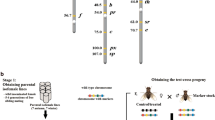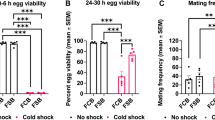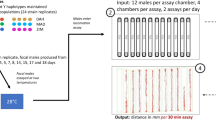Abstract
ALTHOUGH it has now been demonstrated by several workers that crossing-over in certain regions of the chromosomes of Drosophila melanogaster is affected by temperature, the experiment reported in Table 8 of Plough's classical paper1 still remains the only attempt to trace the magnitude of the effect through out the range of temperature over which Drosophila is fertile. Unfortunately, when correcting the data for differences among the controls, a mistake was made which led to the false conclusion that crossing-over showed two maxima, at 13° and at 31° C. The b–pr–c region of chromosome II was used for the experiment. The observed percentages of crossing-over between b and pr are reproduced in the table below: When corrections for the controls are properly applied the relation between crossing-over and temperature is seen to conform to a simple U curve (Fig. 1).
This is a preview of subscription content, access via your institution
Access options
Subscribe to this journal
Receive 51 print issues and online access
$199.00 per year
only $3.90 per issue
Buy this article
- Purchase on Springer Link
- Instant access to full article PDF
Prices may be subject to local taxes which are calculated during checkout
Similar content being viewed by others

References
H. H. Plough, ” The Effect of Temperature on Crossing-over in Drosophila”. J. Expt. Zool., 24, 147–209 (1917).
M. J. D. White, ” The Influence of Temperature on Chiasma Frequency”. J. Genetics, 29, 203–215 (1934).
Author information
Authors and Affiliations
Rights and permissions
About this article
Cite this article
SMITH, H. Influence of Temperature on Crossing-over in Drosophila. Nature 138, 329–330 (1936). https://doi.org/10.1038/138329b0
Issue Date:
DOI: https://doi.org/10.1038/138329b0
This article is cited by
-
Increased exposure to acute thermal stress is associated with a non-linear increase in recombination frequency and an independent linear decrease in fitness in Drosophila
BMC Evolutionary Biology (2015)
-
Estimation of Fine-Scale Recombination Intensity Variation in the white–echinus Interval of D. melanogaster
Journal of Molecular Evolution (2009)
-
Influence of temperature on recombination in yeast
Heredity (1967)
-
Untersuchungen �ber den Einfluss der Temperatur auf die Rekombinationsh�ufigkeit beiSphaerocarpus
Zeitschrift f�r Vererbungslehre (1964)
-
Effect of temperature on crossing-over inNeurospora crassa
Genetica (1959)
Comments
By submitting a comment you agree to abide by our Terms and Community Guidelines. If you find something abusive or that does not comply with our terms or guidelines please flag it as inappropriate.


